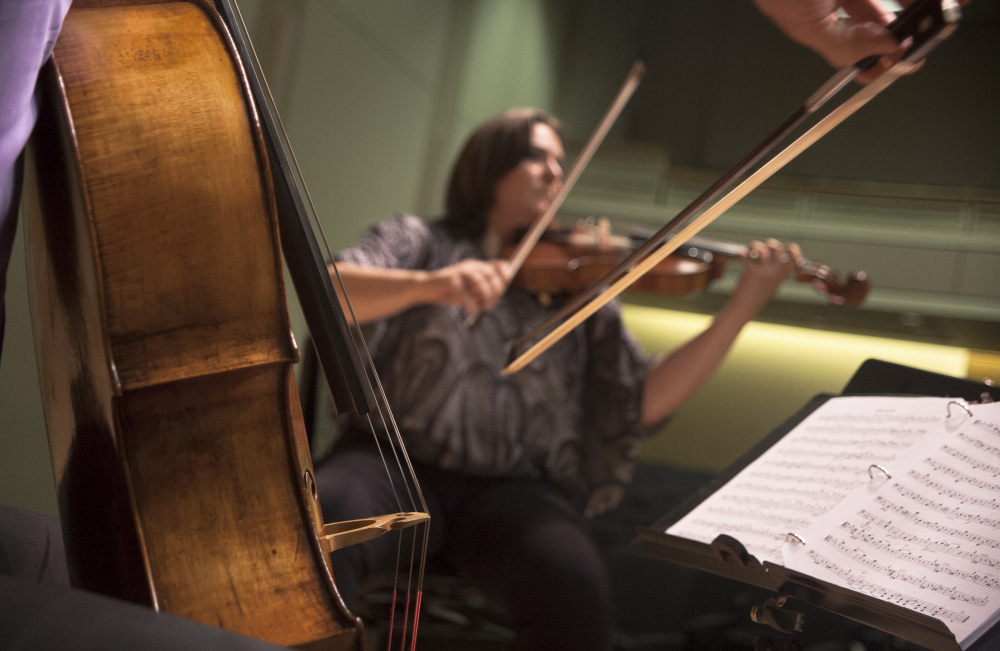The Portland Chamber Music Festival, which opened its 23rd season with a concert at Hannaford Hall on Thursday evening, provides an approach to the chamber repertory that is lacking from the city’s musical life during the regular season. And since the festival presents occasional house concerts, as well as new music at the SPACE Gallery during the winter, maybe its board should consider ways to make it a full-time enterprise, with the chamber music societies that flourish in many cities as its template.
It is not that chamber music is scarce in Portland, but variety definitely is. The Portland and Da Ponte String Quartets each explore the quartet repertory in their own series, with the Da Ponte players occasionally mixing things up with guest collaborators, and the Lark Society, which presents the Portland String Quartet, also offering quartet members’ side projects that look at the repertory for mixed timbres. Portland Ovations sometimes presents mixed-timbre groups, too.
But what the festival offers – and what Portland needs, full time – is a coherently organized program of works for combinations of winds, strings and keyboard, and sometimes percussion and electronics. The repertory is vast, and packed with exquisite scores, the breadth of which can barely be hinted at in a summer festival that presents four programs (a total of 11 works, this year) over nine days.
For its opening concert, the festival offered a pleasant sweep through the last two centuries, with Beethoven’s youthful Trio for clarinet, cello and piano (Op. 11) and Brahms’ late Quintet No. 2 (Op. 111) flanking “Margini Uno,” a short essay in abstract eclecticism, composed in 2010 by Carla Magnan, the Italian composer who won the festival’s 2016 Composers Competition.
There was a bonus, as well. Because Magnan’s work, a piano quartet, is based on elements borrowed from a Chopin Mazurka (Op. 6, No. 3), pianist Diane Walsh gave the Mazurka a suitably jaunty reading as an introduction to Magnan’s score.
As it turned out, Magnan hid her Chopin appropriations amid the work’s briskly shifting string and keyboard textures so well that if Walsh had not played the original, the echoes of Chopin’s rhythms and theme shapes might have gone unnoticed. That’s probably as it should be. In any case, Walsh, with violinist Sunghae Anna Lim, violist Christine Grossman and cellist Trevor Handy, played the music on its own terms, focusing on the lively interplay and ear-catching effects that drive Magnan’s piece, rather than its roots in Chopin.
The Beethoven, for which Walsh was joined by clarinetist Todd Palmer and cellist Peter Stumpf, offered a glimpse of the young Beethoven at a crucial moment in his nascent career, mainly by abandoning hindsight – that is, the image of Beethoven as the stormy, titanic composer he would soon become.
Barely 27 when he wrote the piece, Beethoven was navigating a musical world in which Mozart had been dead only six years, and in which Haydn remained a dominant figure. You can hear their influences – and the stylistic boundaries within which they worked – on this trio’s playful opening movement, its soulful central Adagio and its spirited finale, a set of variations on an aria from a popular opera of the time.
The ensemble played the trio as the courtly entertainment that Beethoven’s publishers no doubt hoped it would be, with Palmer and Stumpf contributing lines etched in bright but warm hues, and Walsh keeping the textures transparent and lively. In doing so, they also showed, without overstatement, the degree to which Beethoven was pushing past the restraints of Classicism, in search of his own voice – something most evident in a series of brusquely accented passages in the otherwise decorous opening movement.
The Brahms, a picture of high-Romantic steaminess, benefited from a lush, full-bodied performance by violinists David McCarroll and Jennifer Elowitch (who is also the festival’s artistic director) and violists Grossman and Rebecca Albers, with Stumpf on cello. The performance had a few fleetingly questionable moments – the violins overpowered the shapely cello line at the start, and some of the attacks in the third movement were not entirely unified. But these issues were quickly overcome in the kind of rich, passionate performance that would be welcome throughout the year.
Allan Kozinn is a former music critic and culture writer for The New York Times who lives in Portland. He can be contacted at:
allankozinn@gmail.com
Twitter: kozinn
Send questions/comments to the editors.



Success. Please wait for the page to reload. If the page does not reload within 5 seconds, please refresh the page.
Enter your email and password to access comments.
Hi, to comment on stories you must . This profile is in addition to your subscription and website login.
Already have a commenting profile? .
Invalid username/password.
Please check your email to confirm and complete your registration.
Only subscribers are eligible to post comments. Please subscribe or login first for digital access. Here’s why.
Use the form below to reset your password. When you've submitted your account email, we will send an email with a reset code.